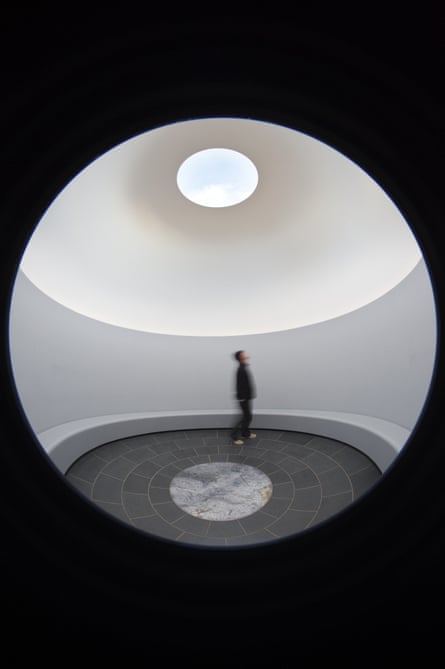James Turrell has worked throughout his five-decade career with an essential ingredient of art: light. From works on paper and holograms to immersive gallery installations and the monumental earth work Roden Crater in Arizona’s Painted Desert, Turrell is fascinated with the perceptual mechanics of vision and how the manipulation of real and artificial light can play tricks on the mind and eye.
The National Gallery of Australia’s retrospective of the artist is a major career survey spanning early 1960s Turrell through to recent pieces, including the gallery’s permanent installation of Within Without (2010). And it gives visitors something that’s pretty rare in contemporary art these days – an experience without need of interpretation or foreknowledge of the artist’s intentions or history. It simply is.
One of the first major works in the show is Joecar (red) from 1968, in which a projector beams red light into an otherwise empty gallery space. Its vertical shape and intensity of colour create the illusion of a doorway or fold in the gallery walls, an effect that is both powerful and elusive. As your eye adjusts to the light the illusion slips away, but soon flips back as the doorway reappears.
The use of light in Bullwinkle (2001) is subtler. Two chairs invite the viewer to watch what appears to be an old-style TV screen set flush into the wall, but in fact turns out to be a window to another wall where the reflected light of a Rocky and Bullwinkle cartoon flickers from black and grey to flashes of yellow, blue and red.
Turrell’s work moves between fixed-point contemplation and total immersion: Raemar pink white (1969) and the later After green (1993) are visual experiences that invite you to consider the oscillating, perceptual magic of colour and form. But the massive Virtuality squared (2014) requires visitors to take off their shoes and put on crime-scene shoe-socks before entering via a carpeted staircase.
Once inside, the shaped white walls and floor give you a sense of looking down, as in a movie theatre, an effect heightened by what appears to be a proscenium arch, before it becomes apparent that the room is changing colour, from white to pink to red and so on, in a 50-minute cycle. The room seemingly fills with mist or smoke, an illusion created by the artist’s deployment of the Ganzfeld effect.
The most extreme of Turrell’s works is Perceptual Cell (2010), an 11-minute long immersive light and sound experience that requires you to lie on your back on a cushioned pallet and then be inserted into a sphere. With headphones fixed to your ears and lights flashing, the experience is intense, trippy and euphoric. The Guardian’s Jonathan Jones gave a detailed account in 2010. All I will add is this: when the lab-coated assistants ask whether you want it “soft or hard”, go hard –there’s not much point doing things by halves.

Turrell’s art deals in the sublime, one of the oldest aesthetic concepts in Western culture. Back in the first century BCE a speech could be fired up with rhetoric that invoked the power of the gods. In Romantic poetry and art, the sublime was revived and refined through images such as the stormy sea, the majestic mountaintop, the infinity of the night sky. And by the late 20th century, the sublime emanated from abstract painting, too: a flat plane of paint acting as a window into an entire universe of colour.
Nowadays, the word sublime – like “terrific” and “awesome” before it – is more likely to describe the flavour of an ice cream than the sights of limitless nature. We get occasional glimpses of the sublime in big-budget, special effects-laden cinema, in games and other simulated environments, but it’s rare to find it in art except as a vague historical reference point.
Turrell’s work invokes the historical concept of the sublime in a way that feels effortless, an absolute presence in the work which the viewer simply feels. The artist has stated that he wants to create art that “makes us begin to see how we see”. The result feels vaguely religious but more than that, an evocation of the infinite that ultimately defeats language itself: the true sublime.

Comments (…)
Sign in or create your Guardian account to join the discussion